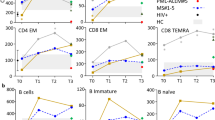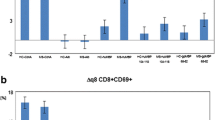Abstract
Myelin basic protein (MBP)-specific T-cell lines from patients with multiple sclerosis (MS) and healthy controls were analyzed for the expression of CD45 isoforms and adhesion molecules. In the multiple sclerosis group, 22 of 24 MBP-specific T-cell lines were CD4+. Two distinct patterns were observed with regard to CD45 isoform expression. Pattern I showed dual expression of CD45 isoforms (CD4+CD45RA+CD45RO+CD29+) and Pattern II included cells with a single CD45 isoform (CD4+CD45RA−CD45RO+CD29+). All 10 cell lines from healthy controls were CD4+ and displayed Pattern II (CD4+CD45RA−CD45RO+CD29+). The dual expression of CD45 isoform in T-cell lines from MS was stable, did not represent a transition stage from CD45RA to CD45RO, and was cell-cycle independent. All cell lines from MS and controls expressed increased levels of LFA-1 (CD11a), LFA-2 (CD2), LFA-3 (CD58), ICAM-1 (CD54), and VLA-4 (CDw49d). These data show the presence of unique MBP-specific T cells (CD4+CD45RA+CD45RO+CD29+) that might play a role in the pathogenesis of MS.
Similar content being viewed by others
References
Wucherpfennig KW, Weiner HL, Hafler DA: T cell recognition of myelin basic protein. Immunol Today 12:277–282, 1991
Martin R, Howell MD, Jaraquemada D, Flerlage M, Richert J, Brostoff S, Long EO, McFarlin DE, McFarland HF: A myelin basic protein peptide is recognized by cytotoxic T cells in the context of four HLA-DR type associated with multiple sclerosis. J Exp Med 173:19–24, 1991
Ben-Nun A, Liblau RS, Cohen L, Lehmann D, Tournier-Lasserve E, Rosenzweig A, Jingwu Z, Raus J, Bach MA: Restricted T cell receptor Vβ gene usage by myelin basic protein-specific T cell clones in multiple sclerosis. Predominant genes vary in individuals. Proc Natl Acad Sci USA 88:2466–2470, 1991
Kotzin B, Karuturi S, Chou YK, Lafferty J, Forrester JM, Better M, Nedwin GE, Offner H, Vandenbank AA: Preferential T cell receptor β-chain variable gene use in myelin basic protein-reactive T-cell clones from patients with multiple sclerosis. Proc Natl Acad Sci USA 88:9161–9165, 1991
Ota K, Matsui M, Milford EL, Mackin GA, Weiner HL, Hafler DA: T cell recognition of an immunodominant myelin basic protein epitope in multiple sclerosis. Nature 346:183–187, 1991
Martin R, Jaraquemada D, Flerlage M, Richert J, Whitaker J, Long EO, McFarlin DE, McFarland HF: Fine specificity and HLA restriction of myelin basic protein-specific cytotoxic T cell lines from multiple sclerosis patients and healthy individuals. J Immunol 145:540–548, 1990
Chou YK, Vainiene M, Whitham R, Bourdette D, Chou CH-J, Hashim G, Offner H, Vandenbark AA: Response of human T lymphocyte lines to myelin basic protein: Association of dominant epitopes with HLA class II restriction molecules. J Neurosci Res 23:207–216, 1989
Zamvil SS, Steinman L: The T lymphocytes in experimental allergic encephalomyelitis. Annu Rev Immunol 8:579–621, 1990
Alleretta M, Nicklas JA, Sriram S, Albertini RJ: T cell responsiveness to myelin basic protein in patients with multiple sclerosis. Science 247:718–721, 1990
Traugott U, Reinharz EL, Raine CS: Multiple sclerosis: Distribution of T cell subsets with active chronic lesions. Science 219:308–310, 1983
Sanders ME, Makgoba MW, Shaw S: Human naive and memory T cells: Reinterpretation of helper-inducer and suppressor-inducer subsets. Immunol Today 9:195–199, 1988
Clement LT: Isoforms of the CD45 common leukocyte antigen family: Markers for human T cell differentiation. J Clin Immunol 12:1–10, 1992
Thomas ML: The leucocyte common antigen family. Annu Rev Immunol 7:339–369, 1989
Morimoto C, Letvin NC, Boyd AW, Hagen M, Brown HM, Kornacki MM, Schlossman SF: The isolation and characterization of the human suppressor-inducer T cell subset. J Immunol 134:3762–3769, 1989
Janossy G, Campana D, Akbar A: Kinetics of T lymphocyte development.In Cell Kinetics of the Inflammatory Reaction, OH Iverson (ed). New York, Springer-Verlag, 1989, pp 59–99
Rose LM, Ginsberg AH, Rothstein DL, Ledbetter JA, Clark EA: Selected loss of a subset of T helper cells in active multiple sclerosis. Proc Natl Acad Sci USA 82:7389–7393, 1985
Morimoto C, Hafler DA, Weiner DL, Letvin NL, Hagan M, Daley J, Schlossman SF: Selective loss of the suppressor-inducer T cell subset in progressive multiple sclerosis: Analysis with anti-2H4 monoclonal antibody. N Engl J Med 316:67–72, 1987
Sobel RA, Hafler DA, Castro EE, Morimoto C, Weiner HL: The 2H4 (CD45R) antigen is selectively decreased in multiple sclerosis lesion. J Immunol 140:2210–2214, 1988
Springer TA: Adhesion receptors of the immune system. Nature 346:425–434, 1990
McDonald WI, Halliday AM: Diagnosis and classification of multiple sclerosis. Br Med Bull 33:4–8, 1977
Eylar EH, Kniskern PJ, Jackson JJ: Myelin basic proteins. Methods Enzymol 32:323–341, 1974
Taylor IW: A rapid single step staining technique for DNA analysis by flow microfluorometry. J Histochem Cytochem 28:1021–1024, 1990
Akbar AN, Terry L, Timms A, Beverley PCL, Jenossy G: Loss of CD45R and gain of UCHL1 reactivity is a feature of primed T cells. J Immunol 140:2171–2178, 1988
Rothstein DM, Yamada A, Schlossman SF, Morimoto C: Cyclic regulation of CD45 isoform expression in a long term human CD4+CD45RA+ T cell line. J Immunol 146:1175–1183, 1991
LaSalle J, Hafler DA: The coexpression of CD45RA and CD45RO isoforms on T cells during the S/G2/M stages of cell cycle. Cell Immunol 138:197–206, 1991
Traugott U, Reinherz EL, Raine CS: Multiple sclerosis: Distribution of T cells, T cell-subsets and Ia positive macrophages in lesion of different ages. J Neuroimmunol 4:201–221, 1983
Waksman BH: Autoimmunity in demylinating diseases. Ann NY Acad Sci 540:13–24, 1988
Clark EA, Ledbetter JA: A leukocyte cell surface antigen: CD45 (LCA, T200) is a protein tyrosine phosphatase. Immunol Today 10:225–278, 1989
Hirohata S, Lipsky P: T cell regulation of human B cell proliferation and differentiation. J Immunol 142:2597–2607, 1989
Rothstein DM, Soshen S, Schlossman SF, Morimoto C: CD4+CD45RA− subset in man maintain distinct function and CD45RA expression persists on a subpopulation of CD45RA+ cells after activation with con A. Cell Immunol 129:449–467, 1990
Bell EB, Sparshott SM: Interconversion of CD45R subset of CD4+ T cells in vivo. Nature 348:163–166, 1990
Selmaj KW, Raine CS: Tumor necrosis factor mediates myelin and oligodendrocyte damage in vitro. Ann Neurol 23:339–346, 1988
Hofman FM, Hilton DR, Johnson K, Merril JE: Tumor necrosis factor identified in multiple sclerosis brain. J Exp Med 170:607–612, 1989
Maimone D, Gregory S, Arnason BG, Reder AT: Cytokine levels in the cerebrospinal fluid and serum of patients in multiple sclerosis. J Neuroimmunol 32:67–74, 1991
Sharief MK, Hentges R: Association between tumor necrosis factor-α and disease progression in patients with multiple sclerosis. N Engl J Med 325:467–472, 1991
Selmaj K, Raine CS, Cannella B, Brosnan CF: Identification of lymphotoxin and tumor necrosis factor in multiple sclerosis lesions. J Clin Invest 87:949–954, 1991
Mossman T, Cherwinski H, Bond M-W,et al.: Two types of murine helper T cell clones. I. Definition according to profile of lymphokine activities and secreted proteins. J Immunol 136:2348–2357, 1986
Romagnani S: Human Th1 and Th2 subsets doubt no more. Immunol Today 12:256–257, 1991
Salgame P, Abrams JS, Clayberger C, Goldstein H, Convit J, Modlin RL, Bloom BR: Differing lymphokine profiles of functional subsets of human CD4 and CD8 T cell clones. Science 254:279–282, 1991
Yamamura M, Uyemura K, Deans RJ, Weinberg K, Rea TH, Bloom BR, Modlin RL: Defining protective responses to pathogens: Cytokine profiles in leprosy lesions. Science 254:277–279, 1991
Albelda SM, Buck CA: Integrins and other cell adhesion molecules. FASEB J 4:2868–2880, 1990
Shimizu Y, van Seventer GA, Horgan KJ, Shaw S: Role of adhesion molecules in T-cell recognition: Fundamental similarities between four integrins on resting T cells (LFA-1, VLA-4, VLA-5, VLA-6) in expression, binding, and costimulation. Immunol Rev 114:109–143, 1990
Sanders ME, Makgoba MW, Sharrow SO, Stephany D, Springer TA, Young HA, Shaw S: Human memory T cells express increased levels of three cell adhesion molecules (LFA-3, CD2, and LFA-1) and three other molecules (UCHL 1, CDw29, and pgp-1) and have enhanced IFNγ production. J Immunol 140:1401–1407, 1988
Pober JS, Gimbrone MA Jr, Lapierre LA, Mendrick DL, Fiers W, Rothlein R, Springer TA: Overlapping patterns of activation of human endothelial cells by interleukin 1, tumor necrosis factor, and immune interferon. J Immunol 137:1893–1896, 1986
Pober JS, Lapierre LA, Stolpen AH, Brock TA, Springer TA, Fiers W, Bevilacqua MP, Mendrick DL, Gimbrone MA Jr: Activation of cultured human endothelial cells by recombinant lymphotoxin: Comparison with tumor necrosis factor and interleukin 1 species. J Immunol 138:3319–3324, 1987
Frohman EM, Frohman TC, Dustin ML, Vayuvegula B, Choi B, van den Noort S, Gupta S: The induction of ICAM-1 on human fetal astrocytes by IFNγ, TNFα, LT, and IL-1. J Neuroimmunol 23:117–124, 1989
Dustin ML, Springer TA: Lymphocyte function-associated antigen-1 (LFA-1) interaction with intercellular adhesion molecule-1 (ICAM-1) is one of the at least three mechanisms for lymphocyte adhesion to cultured endothelial cells. J Cell Biol 107:321–331, 1988
Hemler ME, Elices MJ, Parker C, Takada Y: Structure of integrin VLA-4 and its cell-cell and cell-matrix adhesion function. Immunol Rev 114:45–65, 1990
Hemler ME, Takada Y, Elices M, Croose C: Structure and function for adhesion receptors VLA-2 and VLA-4: Comparison to other members of the integrin superfamily.In Leukocyte Adhesion Molecules, TA Springer, DA Anderson, AS Rosenthal, Rothlein (eds). New York, Springer-Verlag, 1989, pp 44–57
Hemler ME: Adhesive protein receptors on hematopoietic cells. Immunol Today 9:109–113, 1988
Author information
Authors and Affiliations
Rights and permissions
About this article
Cite this article
Qin, Y., van den Noort, S., Kurt, J. et al. Dual expression of CD45RA and CD45RO isoforms on myelin basic protein-specific CD4+ T-cell lines in multiple sclerosis. J Clin Immunol 13, 152–161 (1993). https://doi.org/10.1007/BF00919272
Accepted:
Issue Date:
DOI: https://doi.org/10.1007/BF00919272




